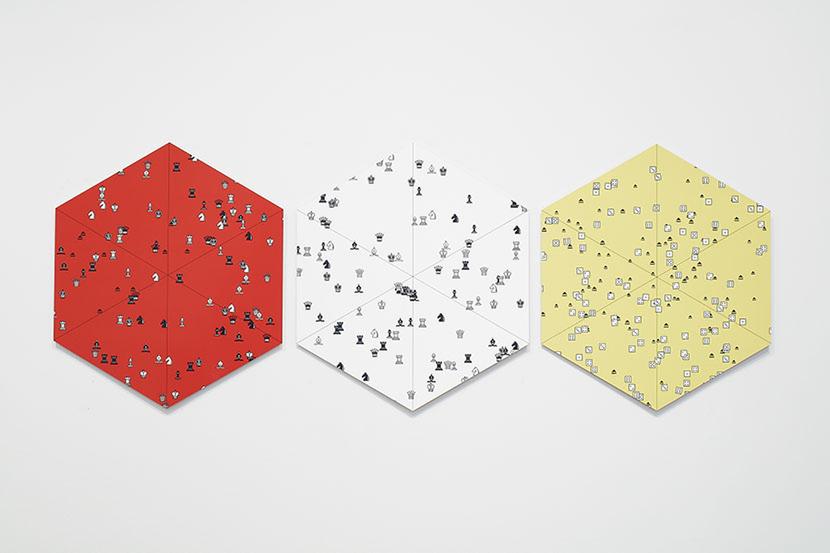Antek WalczakExhibitions
Antek Walczak
For this exhibition, Antek Walczak presents a group of dye sublimation metal prints of pictures made using random pattern generation algorithms. Computer graphics and image processing are utilized to model an image instead of reproducing or representing it. The distinction lies in the conception of a system that constructs pictures of random visual patterns using what is known as a cellular or mosaic approach.
With the mosaic model, a potential image is treated as an arrangement of regions defined geometrically, such as with the tessellation of a planar surface, which in this case are hexagrams with 10 inch sides. The resulting mosaic or cellular structure is populated by figures (symbols and glyphs) evenly distributed across each cell. The figures are then randomized according to parameters relative to their position in each cell, and those of their neighbors. This process of recursion, whereby steps of the procedure invoke the procedure itself, results in patterns with subpatterns and figures possessing topological relationships of a hierarchical character, which can be similar to the nature of many real images.
As a method of content production or content population, the mosaic model has had practical application in the notion of procedural generation. It was used in varying forms during the history of video game design, especially when hardware limitations required the analysis and synthesis of textures according to strict laws of information theory and compression techniques. All the detail in the random placements and patterns of, say, trees in a video game landscape, had to be coded in such a way as to distill them into a few bits of information, which could then generate the desired texture at a future time. The benefits reaped through such economy of means included smaller file sizes, larger amounts of content, and randomness for less predictable gameplay. Today, this procedural generation has advanced far beyond basic texture generation. In the forthcoming video game "No Man's Sky," the entire game's universe is procedurally-generated—including solar systems, planets, weather systems, flora and fauna on these planets, the behavior of these creatures, and artificial structures like buildings and spacecrafts.
Claude Shannon's information theory gave a physical measure—the bit—to the data of a message, regardless of the physical form of the medium (be it picture, sound, motion, or text). Entropy—the part of the equation that represents the unknown, the complex, the random—is overloaded with information while the most common and redundant message can be compressed into a few bits. A message that is new and unknown, different from what has come before, has high entropy and is represented by a large number of bits. According to this theory, it can be said that the essence of information boils down to that which is new or different from all that is previously known, or that which can be derived from previous knowledge.
In an era of electronic influence and trending search results, Walczak attempts to enact a reversal of this loss of the experience of the new or original through a recalibration of values that might have already begun to take place. He does this by focusing on how information is processed in a context of full access and availability, how the experience of knowledge as discovery and emancipation gives way to an experience that feels like sorting or streamlining in order to sanely navigate mountains and oceans of artist-generated content.

